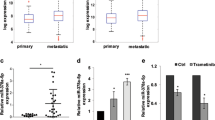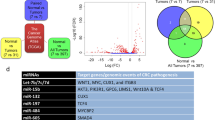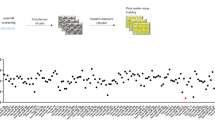Abstract
Targeting oncogenic microRNAs (miRNAs) is emerging as a promising strategy for cancer therapy. In this study, we provide proof of principle for the safety and efficacy of miRNA targeting against metastatic tumors. We tested the impact of targeting miR-182, a pro-metastatic miRNA frequently overexpressed in melanoma, the in vitro silencing of which represses invasion and induces apoptosis. Specifically, we assessed the effect of anti-miR-182 oligonucleotides synthesized with 2′ sugar modifications and a phosphorothioate backbone in a mouse model of melanoma liver metastasis. Luciferase imaging showed that mice treated with anti-miR-182 had a lower burden of liver metastases compared with control. We confirmed that miR-182 levels were effectively downregulated in the tumors of anti-miR-treated mice compared with tumors of control-treated mice, both in the liver and in the spleen. This effect was accompanied by an upregulation of multiple miR-182 direct targets. Transcriptional profiling of tumors treated with anti-miR-182 or with control oligonucleotides revealed an enrichment of genes controlling survival, adhesion and migration modulated in response to anti-miR-182 treatment. These data indicate that in vivo administration of anti-miRs allows for efficient miRNA targeting and concomitant upregulation of miRNA-controlled genes. Our results demonstrate that the use of anti-miR-182 is a promising therapeutic strategy for metastatic melanoma and provide a solid basis for testing similar strategies in human metastatic tumors.
This is a preview of subscription content, access via your institution
Access options
Subscribe to this journal
Receive 50 print issues and online access
$259.00 per year
only $5.18 per issue
Buy this article
- Purchase on Springer Link
- Instant access to full article PDF
Prices may be subject to local taxes which are calculated during checkout



Similar content being viewed by others
Accession codes
References
Bandres E, Malumbres R, Cubedo E, Honorato B, Zarate R, Labarga A et al. (2007). A gene signature of 8 genes could identify the risk of recurrence and progression in Dukes' B colon cancer patients. Oncol Rep 17: 1089–1094.
Brown BD, Gentner B, Cantore A, Colleoni S, Amendola M, Zingale A et al. (2007). Endogenous microRNA can be broadly exploited to regulate transgene expression according to tissue, lineage and differentiation state. Nat Biotechnol 25: 1457–1467.
Camacho LH, Antonia S, Sosman J, Kirkwood JM, Gajewski TF, Redman B et al. (2009). Phase I/II trial of tremelimumab in patients with metastatic melanoma. J Clin Oncol 27: 1075–1081.
Chi KN, Siu LL, Hirte H, Hotte SJ, Knox J, Kollmansberger C et al. (2008). A phase I study of OGX-011, a 2′-methoxyethyl phosphorothioate antisense to clusterin, in combination with docetaxel in patients with advanced cancer. Clin Cancer Res 14: 833–839.
Chijiwa T, Abe Y, Ikoma N, Yamazaki H, Tsukamoto H, Suemizu H et al. (2009). Thrombospondin 2 inhibits metastasis of human malignant melanoma through microenvironment-modification in NOD/SCID/gammaCnull (NOG) mice. Int J Oncol 34: 5–13.
Croce CM . (2009). Causes and consequences of microRNA dysregulation in cancer. Nat Rev Genet 10: 704–714.
Davis ME, Zuckerman JE, Choi CH, Seligson D, Tolcher A, Alabi CA et al. (2010). Evidence of RNAi in humans from systemically administered siRNA via targeted nanoparticles. Nature 464: 1067–1070.
Davis S, Propp S, Freier SM, Jones LE, Serra MJ, Kinberger G et al. (2009). Potent inhibition of microRNA in vivo without degradation. Nucleic Acids Res 37: 70–77.
de Fougerolles A, Vornlocher HP, Maraganore J, Lieberman J . (2007). Interfering with disease: a progress report on siRNA-based therapeutics. Nat Rev Drug Discov 6: 443–453.
Dennis Jr G, Sherman BT, Hosack DA, Yang J, Gao W, Lane HC et al. (2003). DAVID: Database for Annotation, Visualization, and Integrated Discovery. Genome Biol 4: P3.
Devi GR . (2006). siRNA-based approaches in cancer therapy. Cancer Gene Ther 13: 819–829.
Elmen J, Lindow M, Schutz S, Lawrence M, Petri A, Obad S et al. (2008). LNA-mediated microRNA silencing in non-human primates. Nature 452: 896–899.
Esau C, Davis S, Murray SF, Yu XX, Pandey SK, Pear M et al. (2006). miR-122 regulation of lipid metabolism revealed by in vivo antisense targeting. Cell Metab 3: 87–98.
Garbe C, Leiter U . (2009). Melanoma epidemiology and trends. Clin Dermatol 27: 3–9.
Grimm D, Streetz KL, Jopling CL, Storm TA, Pandey K, Davis CR et al. (2006). Fatality in mice due to oversaturation of cellular microRNA/short hairpin RNA pathways. Nature 441: 537–541.
Guttilla IK, White BA . (2009). Coordinate regulation of FOXO1 by miR-27a, miR-96, and miR-182 in breast cancer cells. J Biol Chem 284: 23204–23216.
Hau P, Jachimczak P, Bogdahn U . (2009). Treatment of malignant gliomas with TGF-beta2 antisense oligonucleotides. Expert Rev Anticancer Ther 9: 1663–1674.
Huang da W, Sherman BT, Lempicki RA . (2009). Systematic and integrative analysis of large gene lists using DAVID bioinformatics resources. Nat Protoc 4: 44–57.
Jansen B, Wacheck V, Heere-Ress E, Schlagbauer-Wadl H, Hoeller C, Lucas T et al. (2000). Chemosensitisation of malignant melanoma by BCL2 antisense therapy. Lancet 356: 1728–1733.
Jemal A, Thun MJ, Ries LA, Howe HL, Weir HK, Center MM et al. (2008). Annual report to the nation on the status of cancer, 1975-2005, featuring trends in lung cancer, tobacco use, and tobacco control. J Natl Cancer Inst 100: 1672–1694.
Jiang L, Mao P, Song L, Wu J, Huang J, Lin C et al. (2010). MiR-182 as a Prognostic Marker for Glioma Progression and Patient Survival. Am J Pathol 177 (1): 29–38.
Kota J, Chivukula RR, O'Donnell KA, Wentzel EA, Montgomery CL, Hwang HW et al. (2009). Therapeutic microRNA delivery suppresses tumorigenesis in a murine liver cancer model. Cell 137: 1005–1017.
Krek A, Grün D, Poy MN, Wolf R, Rosenberg L, Epstein EJ et al. (2005). Combinatorial microRNA target predictions. Nat Genet 37: 495–500.
Krumschnabel G, Manzl C, Villunger A . (2009). Caspase-2: killer, savior and safeguard--emerging versatile roles for an ill-defined caspase. Oncogene 28: 3093–3096.
Krutzfeldt J, Rajewsky N, Braich R, Rajeev KG, Tuschl T, Manoharan M et al. (2005). Silencing of microRNAs in vivo with ‘antagomirs’. Nature 438: 685–689.
Lanford RE, Hildebrandt-Eriksen ES, Petri A, Persson R, Lindow M, Munk ME et al. (2010). Therapeutic silencing of microRNA-122 in primates with chronic hepatitis C virus infection. Science 327: 198–201.
Lewis BP, Burge CB, Bartel DP . (2005). Conserved seed pairing, often flanked by adenosines, indicates that thousands of human genes are microRNA targets. Cell 120: 15–20.
Ma L, Reinhardt F, Pan E, Soutschek J, Bhat B, Marcusson EG et al. (2010). Therapeutic silencing of miR-10b inhibits metastasis in a mouse mammary tumor model. Nat Biotechnol 28: 341–347.
Paschos KA, Majeed AW, Bird NC . (2010). Role of Kupffer cells in the outgrowth of colorectal cancer liver metastases. Hepatol Res 40: 83–94.
Poulikakos PI, Zhang C, Bollag G, Shokat KM, Rosen N . (2010). RAF inhibitors transactivate RAF dimers and ERK signalling in cells with wild-type BRAF. Nature 464: 427–430.
Rubin KM, Lawrence DP . (2009). Your patient with melanoma: staging, prognosis, and treatment. Oncology (Williston Park) 23: 13–21.
Segura MF, Hanniford D, Menendez S, Reavie L, Zou X, Alvarez-Diaz S et al. (2009). Aberrant miR-182 expression promotes melanoma metastasis by repressing FOXO3 and microphthalmia-associated transcription factor. Proc Natl Acad Sci USA 106: 1814–1819.
Subramanian A, Tamayo P, Mootha VK, Mukherjee S, Ebert BL, Gillette MA et al. (2005). Gene set enrichment analysis: a knowledge-based approach for interpreting genome-wide expression profiles. Proc Natl Acad Sci USA 102: 15545–15550.
Tolcher AW, Reyno L, Venner PM, Ernst SD, Moore M, Geary RS et al. (2002). A randomized phase II and pharmacokinetic study of the antisense oligonucleotides ISIS 3521 and ISIS 5132 in patients with hormone-refractory prostate cancer. Clin Cancer Res 8: 2530–2535.
Tong AW, Nemunaitis J . (2008). Modulation of miRNA activity in human cancer: a new paradigm for cancer gene therapy? Cancer Gene Ther 15: 341–355.
Trang P, Medina PP, Wiggins JF, Ruffino L, Kelnar K, Omotola M et al. (2010). Regression of murine lung tumors by the let-7 microRNA. Oncogene 29: 1580–1587.
Treisman J, Garlie N . (2010). Systemic therapy for cutaneous melanoma. Clin Plast Surg 37: 127–146.
Tsukita S, Furuse M, Itoh M . (2001). Multifunctional strands in tight junctions. Nat Rev Mol Cell Biol 2: 285–293.
Valastyan S, Weinberg RA . (2009a). Assaying microRNA loss-of-function phenotypes in mammalian cells: emerging tools and their potential therapeutic utility. RNA Biol 6: 541–545.
Valastyan S, Weinberg RA . (2009b). MicroRNAs: Crucial multi-tasking components in the complex circuitry of tumor metastasis. Cell Cycle 8: 3506–3512.
Wiggins JF, Ruffino L, Kelnar K, Omotola M, Patrawala L, Brown D et al. (2010). Development of a Lung Cancer Therapeutic Based on the Tumor Suppressor MicroRNA-34. Cancer Res 70: 5923–5930.
Xu S, Witmer PD, Lumayag S, Kovacs B, Valle D . (2007). MicroRNA (miRNA) transcriptome of mouse retina and identification of a sensory organ-specific miRNA cluster. J Biol Chem 282: 25053–25066.
Yang H, Higgins B, Kolinsky K, Packman K, Go Z, Iyer R et al. (2010). RG7204 (PLX4032), a Selective BRAFV600E Inhibitor, Displays Potent Antitumor Activity in Preclinical Melanoma Models. Cancer Res 70: 5518–5527.
Acknowledgements
We thank members of the NYU Cancer Institute Genomics Facility for array profiling. We are grateful to Dr Cindy Loomis and members of the NYU Histopathology (Tim Macatee) and the Immunohistochemistry Core Laboratories for tissue processing and histological staining, and to Dr Elisa de Stanchina (MSKCC Antitumor Assessment core facility) for mouse blood work. This work was funded by the ConCerN foundation and the Harry Lloyd Charitable Trust. CH is supported by the NYU Physician Scientist Training Program, National Cancer Center Postdoctoral fellowship and the NIH T32 CA09454-19 fellowship training grant. MFS by a National Cancer Center Postdoctoral fellowship.
Author contributions: CH, MFS, SM, EM and EH designed, and CH, MFS, SM, AG-S, BL, LC and EH performed the experiments; CH, MFS, AG-S, FD, JZ, EM and EH analyzed data; BL and DM assisted with the use of the IVIS equipment; CH, MFS, AG-S, IO, EM and EH wrote the paper.
Author information
Authors and Affiliations
Corresponding author
Ethics declarations
Competing interests
EGM is an employee and shareholder of Regulus Therapeutics. All other authors declare no conflict of interest.
Additional information
Supplementary Information accompanies the paper on the Oncogene website
Supplementary information
Rights and permissions
About this article
Cite this article
Huynh, C., Segura, M., Gaziel-Sovran, A. et al. Efficient in vivo microRNA targeting of liver metastasis. Oncogene 30, 1481–1488 (2011). https://doi.org/10.1038/onc.2010.523
Received:
Revised:
Accepted:
Published:
Issue Date:
DOI: https://doi.org/10.1038/onc.2010.523
Keywords
This article is cited by
-
Role of autotaxin in cancer stem cells
Cancer and Metastasis Reviews (2018)
-
The miR-200 family and the miR-183~96~182 cluster target Foxf2 to inhibit invasion and metastasis in lung cancers
Oncogene (2016)
-
Molecular Biomarkers of Colorectal Cancer and Cancer Disparities: Current Status and Perspective
Current Colorectal Cancer Reports (2016)
-
microRNA-182 targets special AT-rich sequence-binding protein 2 to promote colorectal cancer proliferation and metastasis
Journal of Translational Medicine (2014)
-
Stage and tissue-specific prognostic impact of miR-182 in NSCLC
BMC Cancer (2014)



